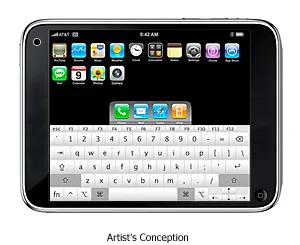Think you know everything about the engimatic Apple tablet? Well, think again, because there is a lot you probably don’t. And there a lot of people guessing the answers. Here’s our roundup of the latest and greatest Apple tablet speculation.
Yes, we all know that Apple is expected to unveil its overhyped tablet on Wednesday, January 27 at a specially planned event in San Francisco’s Yerba Buena Center for the Arts.
But what else do we know?
Well, according to Wired’s Daniel Dumas, the tablet will almost certainly be missing four important features, including wireless power transfer capabilities, a flexible OLED screen, an affordable price tag and a means to saving the struggling print industry.
“Newspapers have been on the business end of a nasty financial ass-kicking for the last few years. A lusty piece of hardware coupled with an innovative, iTunes-based business strategy could make both daily rags and glossies profitable again,” wrote Dumas.

“[But here’s why] it’s a pipe dream: With a rumored $1,000 price tag, we’re betting that even die-hard early adopters won’t be showing up en masse to buy the tablet. Financially, the print industry needs a new mass audience, not a small coterie of dedicated Mac lovers.”
Meanwhile, Chuck La Tournous of the Mac Observer noted that Apple was unlikely to provide Flash support on its brand new tablet.
“So what will a device like this run? I’d hope it would run existing iPhone apps, without modification,” speculated La Tournous.
“I don’t think Apple’s design sensibilities would allow them to just run scaled-up to fit the larger screen, though, so I’ll call for them to run at iPhone resolution, perhaps as a floating window.”
La Tournous added that the device could also be packaged with a number of bundled productivity apps, such as customized versions of Pages [and] iPhoto.
“It will also run new native apps, which will be available only through a new section of the iTunes store (hopefully, more scalable than the iPhone app store has been to this point).”
David Coursey of PC World expressed similar sentiments.
“The tablet seems primarily designed for media consumption and gaming, but should also run current iPhone applications. If you use business apps on your iPhone and long for a larger screen, then the tablet is, for you, a business device,” explained Coursey.

“I hope there will be tablet-specific apps, because it would be nice to implement features that require more screen real estate than the iPhone offers. If all the tablet runs are iPhone apps blown up to fill the larger screen, it would be pretty depressing.”
However, Rob Griffiths of MacWorld dismissed the possibility that Apple would simply “jumbo-size” the iPhone’s approach to presenting and working with programs.
“With a rumored 10 inches of diagonal screen real estate, there are a lot of options for program and home screen management. For ease of math in this example, let’s assume The Tablet has a 10.5-inch diagonal screen, with the same pixel density as the current iPhone (480×320 on a 3.5-inch diagonal screen),” opined Griffiths.

“Clearly, I have no inside knowledge of what interface The Tablet will use for its home screen. However, what I’d like to see is a home screen that’s a mix of the OS X Dock, Dashboard, and Finder.”
Griffiths emphasized that the home screen should be a “living entity” and not a static display of icons for assorted applications.
“So it’s basically like the OS X Dashboard in that regard—you can (somehow) place active applications on the home screen, and they would be updated while the screen was active. If you switch off the display, the apps would sleep, and then update again when you activate the display.”
Well, that just about covers the software and UI side, but what do we know about the hardware responsible for powering the device?
In an article entitled “Why the Apple Tablet (or iSlate) Will Change Everything,” NotebookReview’s Jerry Jackson predicted that the tablet would not use traditional notebook hardware.
“Nvidia is one of Apple’s largest partners when it comes to graphics hardware, but multiple Nvidia representatives have gone off record to state that Nvidia’s new Tegra platform will NOT be powering the iSlate,” revealed Jackson.

“Likewise, you can probably forget about Intel’s Atom processor. While the Atom ‘might’ be an option, the tiny Intel CPU gets hot inside extremely small, fanless enclosures and requires a massive (heavy) battery for more than 6 hours of battery life. Bottom line, Apple should be using non-traditional processors and graphics in the iSlate.”






